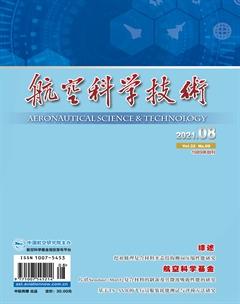直升機主減弧齒錐齒輪優化設計
朱慧玲 周啟航
摘要:弧齒錐齒輪承載傳動時,輪齒交替嚙合與輪齒間齒側間隙的耦合作用使得傳動系統不可避免地產生振動。針對某民用直升機主減速器弧齒錐齒輪傳動系統,基于集中參數法建立非正交弧齒錐齒輪彎-扭-軸耦合動力學模型,并采用Runge-Kutta法求解動力學方程得到傳動系統的動力學特性;以局部綜合法的三個二階參數:接觸跡線與齒高方向的夾角、傳動比一階導數和接觸橢圓半長軸與齒寬的比值為設計變量,傳動系統的振動位移均方根值為優化目標函數,基于遺傳算法進行齒面優化以減振。結果表明,采用從動輪接觸跡線與齒高方向的夾角71°、傳動比一階導數-0.0195、接觸橢圓半長軸與齒寬比值0.1512的微觀參數設計方案,傳動系統的振動幅值降低了9.43%。
關鍵詞:民用直升機;弧齒錐齒輪;非正交;齒面優化;遺傳算法
中圖分類號:V232.8文獻標識碼:ADOI:10.19452/j.issn1007-5453.2021.08.002
直升機具有較好的機動性能、定點懸停以及垂直起降等特點,因此成為無法被替代的交通工具,民用直升機在搜救抓捕、森林滅火、搶險救災、運輸出行等領域也擁有廣闊的市場前景。弧齒錐齒輪常用于相交軸傳動,具有傳動平穩、承載能力高、效率高等特點,廣泛應用于汽車、直升機、船舶等領域,弧齒錐齒輪傳動系統作為直升機主減速器的重要組成部分,其動態特性很大程度上影響了減速器的運轉穩定性及其壽命,進而影響直升機旋翼系統的工作性能。實際應用中,齒輪副存在齒側間隙以避免輪齒卡死和兩嚙合齒面直接接觸,傳遞載荷時存在輪齒交替嚙合,弧齒錐齒輪承載時在非線性因素和時變因素的耦合作用下產生振動與噪聲。弧齒錐齒輪作為不完全共軛齒輪副,齒面幾何學和接觸分析是其動態分析的基礎,國內外許多學者針對弧齒錐齒輪進行了主動設計、動態特性、齒面優化等方面的研究:Litvin等[1-4]提出了局部綜合法,即給定參考點處的傳動比一階導數、接觸跡線與根錐的夾角以及接觸橢圓的半長軸,預控參考點及其附近位置的嚙合性能;方宗德等[5-8]在局部綜合法的基礎上提出了全局優化設計,針對齒輪副的接觸印痕和傳動誤差曲線,優化機床多余的可選參數來消除三階接觸缺陷;Wang等[9-10]建立了準雙曲面齒輪的非線性時變模型,該模型考慮了嚙合剛度、齒側間隙等因素的影響,并求解了動力學特性;王立華等[11-13]基于集中參數法建立弧齒錐齒輪的彎-扭-軸耦合動力學模型,引入狀態變量,基于Runge-Kutta法求解非線性微分方程,研究了激勵頻率對系統動態響應的影響;蘇進展等[14-15]基于集中質量法建立了弧齒錐齒輪八自由度動力學模型,研究了幾何傳動誤差和重合度對齒輪副振動特性的影響,并基于遺傳算法優化小輪加工參數得到大重合度;趙寧等[16]建立了弧齒錐齒輪8自由度動力學模型,并以振動加速度的均方根值為目標函數,大輪齒面嚙合跡線的方向角和傳動比一階導數為設計變量,基于遺傳算法進行優化得到了較優的齒輪副加工參數。
對于民用直升機而言,安全、經濟、舒適為三大主要設計目標,考慮到國內外學者大都是針對正交弧齒錐齒輪建立動力學模型進行分析,齒面微觀優化主要是分析三個二階參數中的單個或兩個因素的影響。本文針對某民用直升機主減弧齒錐齒輪,采用齒面主動設計、輪齒接觸分析、有限元計算等方法,得到齒輪副的重合度和嚙合剛度,以弧齒錐齒輪齒面主動設計中的三個二階參數:接觸跡線與齒高方向的夾角、傳動比一階導數、接觸橢圓半長軸與齒寬比值為設計變量,齒輪副的振動響應為目標函數,基于遺傳算法得到定義域內的最優解,其振動響應通過集中質量法建立彎-扭-軸耦合動力學模型及其方程,采用Runge-Kutta法求解動力學方程得到。
1動力學模型及方程
2優化設計
2.1遺傳算法
遺傳算法[18-20]是根據大自然中生物體進化規律而設計提出的,是一種通過模擬自然進化過程搜索最優解的方法。遺傳算法以編碼空間代替問題的參數空間,以適應度函數為評價依據,以編碼群體為進化基礎,以對群體中個體位串的遺傳操作,實現選擇和遺傳機制,建立一個迭代過程。其基本運算包括編碼、群體設定、初始化群體、適應度評價、選擇、交叉、變異和終止循環條件。
2.2目標函數
基于局部綜合法的弧齒錐齒輪主動設計,設計變量為三個二階參數,即從動輪的接觸跡線與齒高方向的夾角、傳動比一階導數、接觸橢圓半長軸與齒寬的比值;齒輪副傳動過程中不可避免產生振動,會大大影響直升機的振動水平,故將傳動系統的振動位移均方根值作為優化設計目標。建立的優化設計模型為:
3動力學模型及方程
表1為某民用直升機主減速器內弧齒錐齒輪副的相關參數,其中,傳動系統的輸入功率為106.647kW,主動輪的轉速為2097r/min。
基于弧齒錐齒輪三維模型,采用ANSYS有限元軟件求解齒輪副的嚙合剛度離散值,并利用傅里葉級數進行擬合得到時變嚙合剛度;考慮到齒面二階參數與齒輪副的振動特性沒有顯性函數關系,基于重合度、單對齒嚙合剛度以及綜合嚙合剛度之間的關系建立橋梁,其中,基于輪齒接觸分析計算齒輪副的重合度。采用Runge-Kutta法求解傳動系統的動力學方程,去除嚙合初期的瞬態響應以得到穩態下的動態響應,進而計算傳動系統的振動位移均方根值。設計變量的取值范圍及遺傳算法相關參數見表2。
基于上述相關參數,運用遺傳算法進行優化計算,得到如圖2所示的各子代種群平均值優化過程,經過前8次迭代后,振動位移均方根值基本不變可認為已經收斂。整個迭代過程中首、末次優化設計結果見表3,由表2可知,首、末次迭代的設計變量均為有效范圍內的取值。
根據表3的設計變量值,分別計算傳動系統的動態響應如圖3、圖4所示,由時間歷程圖可知,對弧齒錐齒輪進行齒面優化,可降低傳動系統的振動幅值。
4結論
基于集中參數法和Runge-Kutta法求解傳動系統的動態響應,并運用遺傳算法對弧齒錐齒輪進行齒面優化以減振。
針對某民用直升機主減速器弧齒錐齒輪,采用從動輪接觸跡線與齒高方向的夾角71°、傳動比一階導數-0.0195、接觸橢圓半長軸與齒寬比值0.1512的微觀參數設計方案進行齒面優化,齒輪副的振動位移減小。
參考文獻
[1]Litvin F L,Zhang Y,Handschuh R F. Local synthesis and tooth contact analysis of face-milled spiral bevel gears[J]. Forum,1991,1(2):1-11.
[2]Litvin F L,Gutman Y. A method of local synthesis of gears grounded on the connection between the principal and geodetic curvatures of surfaces[J]. ASME Journal of Mechanical Design,1981,103:114-125.
[3]Litvin F L,Fuentes A. Gear geometry and applied theory[M]. Cambridge University Press,2004.
[4]李特文F L.齒輪幾何學與應用理論(精)[M].上海:上海科技出版社, 2008. Litvin F L. Gear geometry and applied theory (fine) [M]. Shanghai:Shanghai Science and Technology Press, 2008.(in Chinese)
[5]方宗德,楊宏斌,周彥偉.高速弧齒錐齒輪動態嚙合質量優化[J].航空學報, 2001, 22(1):69-72. Fang Zongde, Yang Hongbin, Zhou Yanwei. Dynamic meshing quality optimization of high-speed spiral bevel gears[J]. Acta Aeronautica et Astronautica Sinica, 2001, 22(1):69-72.(in Chinese)
[6]方宗德,劉濤,鄧效忠.基于傳動誤差設計的弧齒錐齒輪嚙合分析[J].航空學報, 2002,23(3):226-230. Fang Zongde, Liu Tao, Deng Xiaozhong. Meshing analysis of spiral bevel gears based on transmission error design[J]. Acta Aeronautica et Astronautica Sinica, 2002, 23(3):226-230.(in Chinese)
[7]方宗德,楊宏斌,鄧效忠.弧齒錐齒輪齒面優化修正及計算機仿真[J].航空動力學報, 2002(1):141-145. Fang Zongde, Yang Hongbin, Deng Xiaozhong. Spiral bevel gear tooth surface optimization and correction and computer simulation[J]. Journal of Aerospace Power, 2002(1):141-145.(in Chinese)
[8]方宗德.齒輪輪齒承載接觸分析(LTCA)的模型和方法[J].機械傳動,1998(2):1-3. Fang Zongde. Model and method of gear tooth load contact analysis (LTCA)[J]. Journal of Mechanical Transmission, 1998(2):1-3.(in Chinese)
[9]Wang Hongbin. Nonlinear time-varying gear mesh and dynamic analysis of hypoid and bevel geared rotor systems[D]. Cincinnati:University of Cincinnati,2007.
[10]Wang J,Lim T C,Li M. Dynamics of a hypoid gear pair considering the effects of time-varying mesh parameters and backlash nonlinearity[J]. Journal of Sound & Vibration,2007,308(1-2):302-329.
[11]王立華,黃亞宇,李潤方,等.弧齒錐齒輪傳動系統的非線性振動特性研究[J].中國機械工程, 2007,18(3):260-264. Wang Lihua, Huang Yayu, Li Runfang, et al. Research on nonlinearvibrationcharacteristicsofspiralbevelgear transmission system[J]. China Mechanical Engineering, 2007, 18(3):260-264.(in Chinese)
[12]王立華,李潤方,林騰蛟,等.弧齒錐齒輪傳動系統的耦合振動分析[J].中國機械工程, 2006(14):4-7. Wang Lihua, Li Runfang, Lin Tengjiao, et al. Coupling vibration analysis of spiral bevel gear transmission system[J]. China Mechanical Engineering, 2006(14):4-7.(in Chinese)
[13]王立華.汽車螺旋錐齒輪傳動耦合非線性振動研究[D].重慶:重慶大學, 2003. Wang Lihua. Research on coupled nonlinear vibration of automobile spiral bevel gear transmission[D]. Chongqing: Chongqing University, 2003.(in Chinese)
[14]蘇進展,魏剛,楊羽,等.大重合度弧齒錐齒輪設計與分析[J].西安交通大學學報, 2021(3):1-9. Su Jinzhan, Wei Gang, Yang Yu, et al. Design and analysis of spiral bevel gears with high contact degree[J]. Journal of Xian Jiaotong University, 2021(3):1-9.(in Chinese)
[15]蘇進展,方宗德,賀朝霞.基于嚙合特性的弧齒錐齒輪動力學研究[J].機械科學與技術,2016, 35(1):50-55. Su Jinzhan, Fang Zongde, He Zhaoxia. Research on dynamics of spiral bevel gears based on meshing characteristics[J]. Mechanical Science and Technology,2016, 35(1):50-55.(in Chinese)
[16]趙寧,康士朋,郭輝,等.基于遺傳算法的弧齒錐齒輪動態特性優化設計[J].航空動力學報, 2010(10):2396-2402. Zhao Ning, Kang Shipeng, Guo Hui, et al. Optimal design of dynamic characteristics of spiral bevel gears based on genetic algorithm[J]. Journal of Aerospace Power, 2010(10):2396-2402.(in Chinese)
[17]李飛,袁茹,朱慧玲.計及齒面摩擦的弧齒錐齒輪動態特性[J].航空動力學報,2020,35(8):1687-1694. Li Fei, Yuan Ru, Zhu Huiling. Dynamic characteristics of spiral bevel gears with tooth surface friction[J]. Journal of Aerospace Power, 2020, 35(8):1687-1694.(in Chinese)
[18]陳國良,王熙法,莊鎮泉,等.遺傳算法及其應用[M].北京:人民郵電出版社, 1999. Chen Guoliang, Wang Xifa, Zhuang Zhenquan, et al. Genetic algorithm and its application[M]. Beijing: Posts & Telecom Press, 1999.(in Chinese)
[19]李敏強.遺傳算法的基本理論及其在知識發現中的應用研究[D].天津:天津大學,2000. Li Minqiang. The basic theory of genetic algorithm and its applicationinknowledgediscovery[D]. Tianjin:Tianjin University,2000.(in Chinese)
[20]馮廷智,成紅芳.基于遺傳算法的航空機載軟件測試用例優先級技術研究[J].航空科學技術, 2018, 29(11):60-65. FengTingzhi,ChengHongfang.Researchonpriority technology of aviation airborne software test cases based on genetic algorithm[J]. Aeronautical Science & Technology, 2018, 29(11):60-65.(in Chinese)
Optimal Design of Helicopters Main Spiral Bevel Gear
Zhu Huiling,Zhou Qihang
China Helicopter Research and Development Institute,Jingdezhen 333001,China
Abstract: When the spiral bevel gear is carrying transmission, the coupling effect of the alternate meshing of gear teeth and the tooth side gap between the gear teeth makes the transmission system inevitably vibrate. For a civil helicopter main reducer spiral bevel gear transmission system, the bending-torsion-axis coupling dynamic model of non-orthogonal spiral bevel gears is established on the basis of the centralized parameter method; and the RungeKutta method to solve the dynamic equations is used to obtain the dynamic characteristics of the transmission system. The three second-order parameters of the local synthesis method: the angle between the contact trace and the tooth height direction, the first derivative of the transmission ratio, the ratio of the semi-major axis of the contact ellipse to the tooth width are design variables, the root mean square value of the vibration displacement of the transmission system is the optimization objective function, and the tooth surface is optimized based on the genetic algorithm to reduce vibration. The results show that when the angle between the contact trace of the gear and the tooth height direction is 71°, the first derivative of the transmission ratio is -0.0195, the ratio of the semi-major axis of the contact ellipse to the tooth width is 0.1512, the vibration amplitude of the transmission system can be reduce by 9.43%.
Key Words: helicopter; spiral bevel gear; non-orthogonal; tooth surface optimization; genetic algorithm

